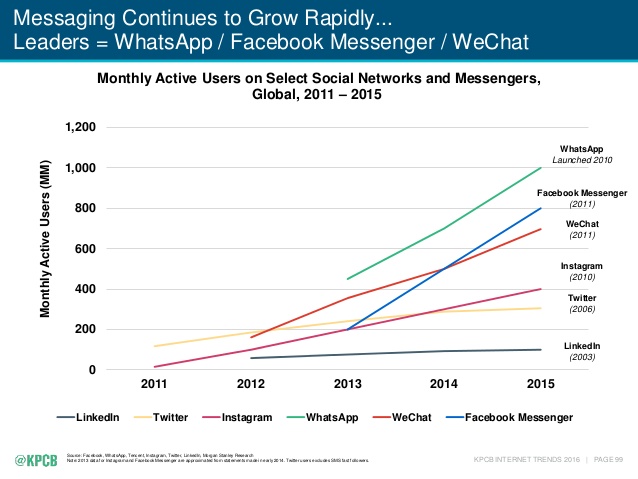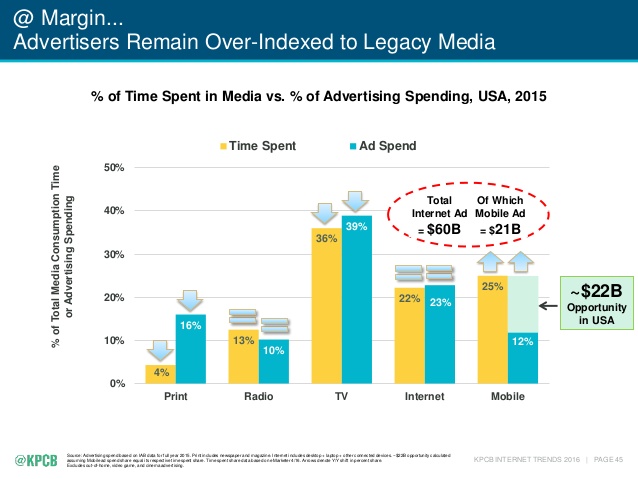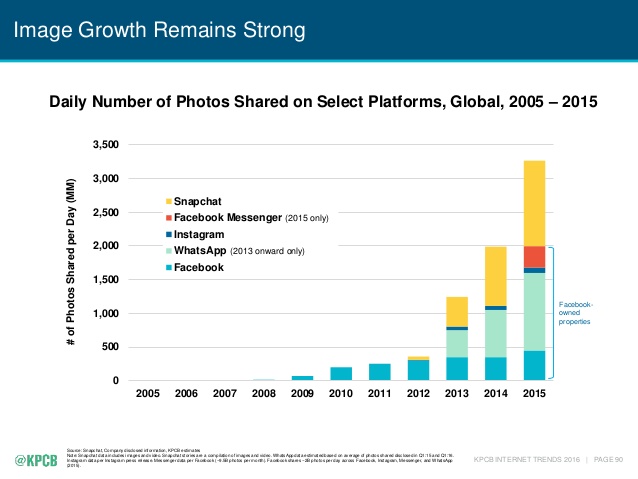
Mary Meeker. Photo courtesy of KPCB
Every year, digital technology and business observers look forward to the 2016 Internet Trends Report from Mary Meeker, a venture capital analyst at Kleiner Perkins Caufield & Byers. With 213 slides, this year’s report is bursting with data on digital trends as well as the global economy and auto manufacturing. While perceptive digital PR and marketing professionals may be aware of many of those overall trends, the slides offer a wealth of information.
Here are the main takeaways especially applicable to marketers.
Digital growth slows. Growth of the internet and the spread of smartphones are slowing due to high penetration. Yearly global internet user growth slowed to 9 percent between 2014 and 2015. Most people who can afford smartphones in developing countries are already online. Those who are not online in poorer nations have difficulty affording the steep prices of smartphones and cell service.
Mobile advertising is underused. Internet advertising exploded from nothing to $60 billion in 20 years. Yet it still has room to grow. Consumers have shifted their attention to the internet, especially through mobile devices. But advertisers remain overly enamored with traditional media and underspend on mobile advertising by about $22 billion. That presents an opportunity for businesses with effective mobile advertising campaigns. While Google still dominates online advertising, Facebook is growing faster, with 59 percent advertising revenue growth between 2014 and 2015, compared to Google’s 18 percent increase.
Many online video ads are ineffective. Citing data from ad tech company Unruly, Meeker says 81 percent of viewers mute video ads, 62 percent consider forced pre-rolling views of videos annoying, and 93 percent consider using ad blocking software. Google, with its $75 billion of revenue last year, has proven that online advertising works. The best online ads, she says, are:
- Authentic,
- Entertaining,
- Evoke emotion,
- Personal/relatable,
- Useful,
- Viewer controlled, and
- Work with the sound off.
Ad blocking is exploding. Use of ad-blocking software is up 94 percent year over year, led by China and India. Advertisers face a possible backlash if they don’t provide a less disruptive, user-friendly experience.
Internet-enabled retailers are on the rise, bolstered by always-on connectivity, hyper-targeted marketing combined with images and personalization. Those that embrace mobile shopping and improve products with feedback data from customers will have an advantage.
Generational differences are significant. Meeker describes the emerging Generation Z, those under 20, as creators and collaborators, future focused and realists. Millennials are curators and sharers, now-focused and optimists.
Images and videos will become more important. Generation Z members communicate with images; user-shared video views are increasing fast. Visual-centric networks like Facebook, Snapchat and Instagram will gain over text-heavy networks like LinkedIn and Twitter. As a result, visual storytelling will become more important.
Voice will become the new paradigm. Voice interfaces are fast, easy and personalized and will become the most efficient way to search online. As speech recognition accuracy reaches 99 percent, voice will become the predominant means of person to computer interactions. In five years, at least 50 percent of searches will be made through images or speech.
Messaging apps may replace the home screen as the de facto internet portal. Messaging, which is dominated by Facebook and WeChat, is growing rapidly and evolving from simple text communication to become our new home screen with options for vivid self-expression and commerce.
Bottom Line: Marketers and brand managers must be aware of and respond to growing and emerging trends to ensure sustained success. Marketers who effectively embrace new technology trends described in the highly acclaimed 2016 Internet Trends report will gain a competitive advantage.
William J. Comcowich founded and served as CEO of CyberAlert LLC, the predecessor of Glean.info. He is currently serving as Interim CEO and member of the Board of Directors. Glean.info provides customized media monitoring, media measurement and analytics solutions across all types of traditional and social media.







Mobile is the biggest trend for this year and it is something brands need to think about. Are you mobile friendly?